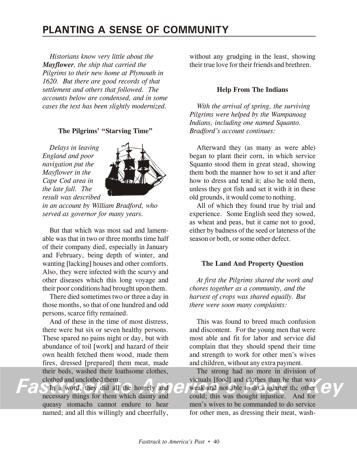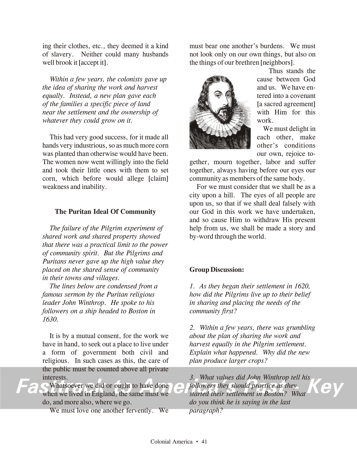| Fasttrack
to America's Past Teacher Key |
|
| Fasttrack
to America's Past Teacher Key |
|
 Page 40  Page 41 |
Pages 40
& 41 - Planting a Sense of Community The reading selection The theme connecting all these readings is found in the title: "Planting a Sense of Community." The selections touch on the community spirit and brotherhood shown by the Pilgrims and Puritans, and also by the Native American named Squanto. The reading selection titled "The Land and Property Question" raises the difficult question of the limits of community action. The original plan of "share and share alike" did not produce enough food from the fields. Within a few years, the Pilgrims assigned individual plots to families. As the reading tells, suddenly the settlers were more eager to work, and the harvest was much larger than before. Students may ask if the original plan was an example of communism or socialism. Those terms usually refer to political and economic ideas that grew in the 1800s and 1900s. It's probably better to use a term like "communal" for the Pilgrims' first plan for producing crops. Certainly it is worth pointing out that the same basic result that ended the Pilgrim's communal plan also ended communism in the Soviet Union. The Pilgrims, of course, realized the mistake in their plan much more quickly than Soviet leaders did. Students can connect with this easily if they are asked about "group work" projects they have been involved with in their classes. What are the benefits of group work assignments compared to individual assignments? What problem often arises on group assignments? Which do they prefer? The pictures The drawing on page 40 shows a ship of about the size and shape of the Mayflower. Not much is known about the ship, and there are no actual images of it in the historical record. Students can use an Internet search engine to track down what is known about the Mayflower. A building in England may contain timbers taken from the ship when it was eventually sold and broken up for scrap. The drawing on page 41 is a well-known image of John Winthrop, the famous leader of the Puritans. His writings and sermons give a good window into the ideals of the early settlers of Massachusetts.
1. The Pilgrims barely survived the first winter
at Plymouth, and only because of the selflessness shown by those
healthy
enough to help the others. Scurvy and other diseases struck, and
the cold winter added to their miseries. Half of the group died
the
first winter. |
|
Copyright Notice
Copyright 2018 by David Burns. All rights reserved. Illustrations and reading selections appearing in this work are taken from sources in the public domain and from private collections used by permission. Sources include: the Dover Pictorial Archive, the Library of Congress, The National Archives, The Hart Publishing Co., Corel Corporation and its licensors, Nova Development Corporation and its licensors, and others. Maps were created or adapted by the author using reference maps from the United States Geological Survey and Cartesia Software. Please see the home page for this title for more information. |